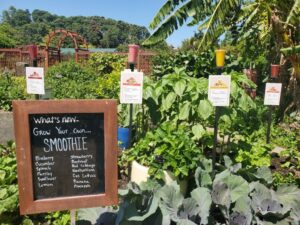
Innovative ways to engage visitors through edible plants
A menu of options on display
By Angela Anstis and Barbara Wheeler
Encourage. Hook. Seize. Influence. Encouraging or inspiring people to see plants, hooking them in, seizing their attention longer than just ‘click bait’, and influencing them to act beyond the garden gate is at the heart of most botanic gardens worldwide. In this article, we look at two innovative ways we engage our visitors using edible plants.
Themed displays – grow your own
Each year in the Edible Garden at Auckland Botanic Gardens, engaging and creative displays are rolled out, themed to group plants together into popular “Grow Your Own” food that children and adults can get excited about. The theme for summer 2024 was growing your own “pizza and pasta”, followed in winter by “winter soup and stir fry”. For the summer that has just passed it has all been about “smoothies”, and coming up this winter “soup and winter salad” will be on the display menu.
These exciting and engaging displays aim to connect visitors with edible plants, encourage people to grow and eat fresh vegetables year-round, and give visitors an understanding of the different ways to use more vegetables in their diet. The winter salad idea was picked because many people think salads are solely summer vegetables. The display promotes and showcases different vegetables and how to use them as salads in winter. For the smoothies, it was about promoting easy breakfasts using fresh vegetables.

It is not just the displays that can capture attention. Signs interpret the displays for visitors, and provide growing tips and recipes to inspire people to have a go at home by breaking down what some may think of as too hard to do at home, to something that becomes possible with just a few easy pointers. Some signs are permanent for the life of the display, while temporary messaging on chalkboards is used for recipes, tips and uses.
The displays are a visual and sensory journey for the novice or the experienced. Using easily obtainable plants that people can have success with at home is key to making the displays connect with people. Selecting plants that grow well in the Auckland area is also important. Novice gardeners will continue to have a go when they experience success with their first efforts. For the more experienced gardener, the connection can be through expanding their knowledge of the range of varieties available and the different flavour profiles available. Basil provided this in the pizza and pasta theme, where multiple types of basil were displayed.
“Pester Power” has power and impact beyond the botanic gardens’ boundary. There is nothing quite like the power of a child repeatedly asking, “why can’t we have a pizza garden at home?”
Meet the gardener sessions
Feeding the curiosity of visitors is important in botanic gardens, and being able to connect visitors with experts is a way to do this. However, there is an expectation that when people see gardeners working, they don’t want to interrupt them with questions. “Meet the gardener” takes this awkwardness for visitors out of the equation. The gardener is focused on the visitor, and the visitor has a captive audience in the gardener, removing the barrier between gardener and visitor.
“Meet the Gardener” originated from Collection Curator Angela Anstis’s visit to RBG Edinburgh (RBGE), where she experienced a similar initiative in place. Angela saw it as a powerful yet informal way to interact with visitors.
The initiative is now in its second year after initially being trialled for six months. It is low-cost and includes two signs, some social media and website promotion, and all that’s needed is Angela’s time for 45 minutes every fortnight (with a break in December to February). As with RBGE, there is a split of visitors actively choosing to come along to the session or those who just happen to pass the Edible Garden and find the session.

Some months will have a theme such as garden bed preparation, to give people confidence in what they will learn at that time. Future themes around seasonal planning and green cropping are planned. The rest of the sessions are open to informal chats and questions.
So far, visitors to New Zealand and Tāmaki Makaurau Auckland have shown great interest in learning about what vegetables grow in a subtropical climate. Equally, locals are interested in the timings of planting and harvesting, the type of plants to grow, organics, what plants to grow in the specific aspect and soils of their garden, and the frequency of watering.
“Meet the Gardener” sessions are high engagement and allow interested visitors to connect in a meaningful way, learn something new, have their questions answered and be inspired to make a return visit to the Botanic Gardens. Conversely, they also inspire Angela, and she learns a thing or two from visitors’ experiences – like the time an Italian visitor shared using black basil in homemade crackers to accompany tomato soup, or when a new migrant to Aotearoa New Zealand shared seeing a vegetable in the Edible Garden that they recall growing in their country of birth and wanted to learn about growing vegetables in their new home city.
Whether encouraging people new to gardening to try growing food in their home gardens, or inspiring old hands to try something new, the theming of displays and connecting visitors to gardeners both provide a hook to seize visitors’ attention and hopefully influence them beyond the botanic garden gates.
